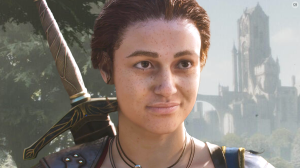Batman: One Bad Day – The Riddler delivers the first of eight prestige one-shot publications intended to showcase Batman’s most iconic villains from a collection of DC Comics’ most-accomplished modern artists and writers. The title itself sets expectations as the phrase “One Bad Day” is tied closely to an infamous Batman tale with a similar set up: Batman: The Killing Joke in which Alan Moore and Dave Gibbons delivered their definitive take on the Joker. It’s a potent comic book that continues to engage Batman readers after nearly thirty-five years, and a fine point of inspiration for that exact reason. Yet the first installment of One Bad Day is so devoted to crafting an homage to The Killing Joke that it never bothers to define the most significant portion of its title: The Riddler.
Videos by ComicBook.com

The story begins with Riddler murdering a man seemingly without cause or even any clues from the enigmatic villain. It proceeds along a familiar route including interrogations by Jim Gordon, Batman’s investigation of the crime, explanatory flashbacks to Riddler’s origin, and a final showdown between hero and villain. Page structures, as well as the narrative, are designed to emulate The Killing Joke heavily utilizing a nine-panel grid and dense layouts. With such profuse connections, One Bad Day – The Riddler is clearly in conversation with its eponymous source material, which raises the question: What does it have to say in response?
In contrast to its title, One Bad Day – The Riddler provides an extensive look at both Edward’s childhood and his current state. Rather than being broken by one awful day, Edward’s lifestyle is rooted in childhood abuse. He is depicted as a brilliant young man excelling in prep school against older students in spite of an abusive father and absent mother. His greatest challenge is a teacher more interested in intellectual stimulation than rote memorization because Edward finds himself unable to creatively solve riddles on their exams.
This gestures broadly at root causes for Edward’s obsessive, violent and often cruel modus operandi. There is the question of nature versus nurture as his intellectual gifts become another source of abuse from an unfit parent; it addresses the limitations of intelligence without empathy or creativity; class is addressed, albeit briefly, as Edward is made to feel out of place as a poor but capable child. Lots of concepts are touched upon in the narrative, but they are never woven together. A lack of creativity is inconsistent with his accomplishments as The Riddler and there are few connections between those childhood traumas and his modern mission. The Killing Joke retains its power, in part, because it suggests a compelling cause for evil, but this reads with the consistency and thought of another dashed off, disconnected op-ed in The New York Times explaining away violent, young, white men. It states that hurt people hurt people, which provides little insight or interest, even if it remains true.
Mitch Gerads provides a suitable atmosphere for these dark proceedings with a scratchy and shadow-filled vision of the city and many violent actions occurring within. In a story that largely avoids colorful costumes, he crafts individuals who are easily recognizable—essentially wearing personalities on their faces—whether they’re a kindly mentor or harsh headmaster. His color work is every bit as impressive in staging different periods of time and perspectives. Black & white recordings and juxtaposition of past and present are utilized with clear effect ensuring that the narrative is clearly told and enjoyable on a base genre level, if nothing else.
Ultimately, Batman: One Bad Day – The Riddler fails to distinguish itself from the source of its homage. Structure, style, and theme are devoted to a comic that is, frankly, a lesser work for both Moore and Gibbons, and cannot bear the weight of repetition. This is seen clearly in the final few pages when a popular fan-reading of The Killing Joke‘s conclusion is made into an all-but-explicit conclusion for this story without much consideration about how it reflects upon either character involved. It’s abundantly clear that King and Gerads possess a great deal of respect for their predecessors but little to build upon that legacy.
Published by DC Comics
On August 16, 2022
Written by Tom King
Art by Mitch Gerads
Colors by Mitch Gerads
Letters by Clayton Cowles
Cover by Mitch Gerads








